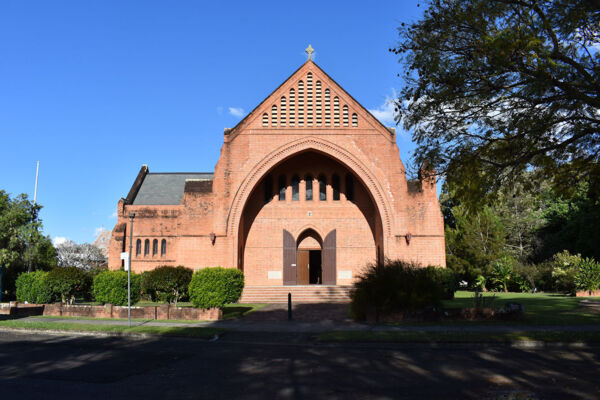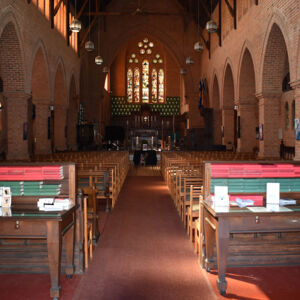Grafton, NSW - Christ Anglican Cathedral
Denomination: Anglican
Address: Duke Street, Grafton, New South Wales, 2460
Architect: John Horbury Hunt
Traditional Owners: Bundjalung people
Last Updated: 16/04/2023
History and Architecture:
The cathedral was designed by John Horbury Hunt and built from 1874 to 1884 by Reynold Brothers (brickwork) and G. J. T. Lawson (woodwork). Of Gothic architectural style the cathedral is built of local salmon-pink bricks, mainly in English bond. It consists of an eight bay nave, sanctuary, side aisles, a side chapel, a baptistry, clergy vestry and choir vestry.
Massive scale emphasised by use of an enormous and dramatic double archway of decorative brickwork spanning the west end. A smaller arch of similar design is in the chancel. Over 90 different patterns of ornamental brickwork were used in its completion. The nave has an open timber roof, supported by space trusses, while close spaced trusses span the sanctuary. The cathedral seats 1000 people.
Building commenced in 1881. By 1884 only three bays of the nave, the tower and the chapter house had been built. Except for the tower these were completed in 1937, to Hunt's original design, the bricks being made from the same clay and moulds as the original work.
A plaque reads. "A M D G This plaque was unveiled by His Excellency, Air Marshall Sir Jamess Rowland, KBE DFC AFC K St J Governor of New South Wales on 12th July, 1984 to mark the completion of the restoration of Christ Church Cathedral in its centenary year. The Rt Revd D N Shearman OBE Bishop. The Very Revd R W Hurford Dean Dr G R Vesey Bishop's Warden and Charirman of the Cathedral Restoration Committee".
A foundation stone for the extension reads, "This foundation stone of the Cathedral extension was laid by Fairfax Bell MA MB B Ch on 27th June 1934 during the Cathedral Jubilee Celebrations. J W Ashton MA DD Bishop G P M Ware Sub Dean".
A stone tablet reads, "The completed Nave and the Baptistry of this Cathedral Church were dedicated by The Bishop of the Diocese on October 30th 1937".
A stone tablet reads, "A M D G This Centenary Commemorative Stone was dedicated by The Right Reverend Donald N Shearman OBE Seventh Lord Bishop of Grafton on The Feast of St James, Apostle and Martyr the 25th July, 1984. The 100th Anniversary of the opening and dedication of The Cathedral Church of Christ the King The Very Reverend Richard W Hurford Fifth Dean of Grafton".
A stone tablet reads, "To the Glory of God and in grateful memory of Francis Lendon Bell MA Priest who with his sons Fairfax, Hilary & Lendon by a generous gift made possible the extensions to this Cathedral 1934 - 1937 This stone was set on the fourteenth day of September 1959 by Nigel Ashton for his father John William Ashton Second Bishop of this Diocese".
A further stone tablet reads, "In memory of J F Munnings ARIBA FRAIA Architect for the extensions to this Cathedral who died before the work was completed. Twenty ninth day of September 1937 Erected by his fellow workers".
Clergy:
These names are now in the Database and can be searched individually.
| Years | Name | Annotation | D.o.B | D.o.D |
|---|---|---|---|---|
| 1896 - | Rev Alfred Dallas | 1856 | 1899 | |
| 1898 - 1904 | Canon William Dalton | 1857 | 19939 | |
| 1904 - | Rev Herbert Percy Lomas | Deacon | 1876 | 1956 |
| 1907 - | Rev Nathan Middleton LLoyd | Deacon | 1861 | 1937 |
| 1910 - | Rev Nathan Middleton LLoyd | 1861 | 1937 | |
| 1911 - 1912 | Rev Henry Lilley | Curate | 1873 | 1932 |
| 1924 - 1926 | Canon Henry Percy Lomas | 1876 | 1956 | |
| 1950 - | Rev Hugh Jerrard Lovibond | 1876 | 1941 | |
| 1957 - | Rev Robert Samuel Date |
Organ:
The first organ was installed in Christ Church Cathedral in 1884 at a cost of 450 pounds. The current Organ was built by Norman & Beard in 1903. Rebuilt in 1967 by Hill, Norman & Beard for the Auditorium of the Royal College of Organists in London. Refurbished and re-erected in Grafton Cathedral in 1992 by Peter D.G. Jewkes Pty Ltd of Sydney.
A full description can be seen here.
Source:
1.Wikipedia. Click here to read the full history.
2. Cable Clerical Index.
3. Organ Historical Trust of Australia with permission.

